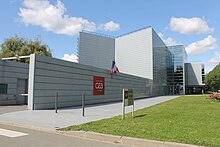| CEA Paris-Saclay | |
 East entrance of Saclay site of CEA Paris-Saclay center East entrance of Saclay site of CEA Paris-Saclay center | |
| Formation | March 1, 1946; 78 years ago (1946-03-01) |
|---|---|
| Location |
|
| Board of directors | Hervé Barbelin (2024–present) |
| Parent organization | French Alternative Energies and Atomic Energy Commission (CEA) |
| Website | www |
| Formerly called | CEA Saclay center (+ separate sites) |
The CEA Paris-Saclay center is one of nine centers belonging to the French Alternative Energies and Atomic Energy Commission (CEA). Following a reorganization in 2017, the center consists of multiple sites, including the CEA Saclay site (formerly a "center"), the Fontenay-aux-Roses site and the sites of Paris, Évry, Orsay and Caen.
Historically, as the main Saclay site was the heart of French nuclear research it was called Saclay Nuclear Research Center prior to the shift towards other fields of research and innovation besides nuclear.
The center has close ties with Paris-Saclay University, being located on the Saclay plateau and active in the Paris-Saclay project for innovation.
Organization

Since February 2017, various sites were grouped together to the CEA Paris-Saclay center, including
- Saclay site (formerly a "center")
- Fontenay-aux-Roses site
- Paris site
- Évry site (Genoscope)
- Orsay site (Service Hospitalier Frédéric Joliot, SHFJ)
- Caen site (GANIL and CIMAP [fr])
History
On 10 October 1945, Charles de Gaulle launched the CEA. In 1946, the Fontenay-aux-Roses site was realized, followed by the Saclay site 6 years later in 1952. The Saclay site, located 20 km south of Paris on the Saclay plateau, is much bigger and was chosen in part to be close to Université Paris-Sud (which today is part of Paris-Saclay University).
The Saclay site was designed by the architect Auguste Perret.
Research
The complex employs more than 7,500 scientists. Although CEA Saclay was initially focused on nuclear research, multiple domains of research are carried out there since a few decades back. These include:
- Low-carbon energies
- Climate and environment
- Matter and universe
- Health and life sciences
- Technology for industry
Reactors
The Saclay site has been home to multiple nuclear research reactors, including the Osiris [fr], Isis [fr] and Orphée [fr] reactors.
The Osiris and Isis reactors (operated between 1965–2019) inspired the design of Iraq's Osirak [fr] facility. Multiple bacterial species were discovered to thrive in those reactor cores during operation, and may have fed off hydrogen from radiolysis.
Notable subsidiaries
- National Institute for Nuclear Science and Technology (INSTN), which is dedicated to the academic and professional training in the field of atomic energy.
- Saclay Institute of Matter and Radiation [d] (IRAMIS), which houses the Lasers, Interactions and Dynamics Laboratory [d] (LIDyL) joint research unit where both Anne L'Huillier and Pierre Agostini attained breakthroughs in attosecond lasers, leading to their Nobel prize share in 2023.
- NeuroSpin is a neuroimaging research center with some of the most powerful MRI machines in the world
Director of the site
- Hervé Barbelin (2024–present)
- Christian Bailly (2021–2024)
- Michel Bédoucha (2016–2021)
- Jacques Vayron (2012–2016)
- Yves Caristan (2005–2012)
- Jean-Pierre Pervès (2000–2005)
- Eliane Loquet (1993–2000)
- Jean Bazin (1990–1993)
- Paul Delpeyroux (–1990)
- ...
- Jean Debiesse [fr] (1954–1970)
- Jules Guéron (1951)
People
- Jules Guéron, first director of the CEA's nuclear research center
- Jean-Baptiste Waldner, alumnus
- Étienne Klein, physicist, philosopher of science, author, and radio host
- Anne L'Huillier, ultra-fast laser physics, 2023 Nobel laureate in physics
- Pierre Agostini, pioneer of strong-field laser physics, 2023 Nobel laureate in physics
- Valérie Masson-Delmotte, climate scientist, co-chair of Working Group 1 of the IPCC
References
- ^ "Institutionnel Plans d'accès". CEA.fr (in French). 2020-08-21. Retrieved 2023-12-09.
- "Du génie nucléaire au génie biologique" (in French). Retrieved 3 October 2023.
- Rayner-Canham, Marelene F. (1997). A Devotion to Their Science: Pioneer Women of Radioactivity. Philadelphia, Pa.: Chemical Heritage Foundation. pp. 97–123. ISBN 978-0-7735-6658-3. OCLC 191818978.
- fontenay-aux-roses
.cea .fr /far /Pages /Le-centre /histoire .aspx - joliot
.cea .fr /drf /joliot /en /Pages /research _entities /SHFJ /Presentation .aspx - "CIMAP - Presentation (English)". cimap.ensicaen.fr. Retrieved 28 December 2023.
- ^ "Histoire du site CEA de Saclay : Le plus grand centre de recherche en Europe". 2022-11-25. Retrieved 2023-10-08.
- "CEA de Saclay: le palais de la science d'Auguste Perret" (in French). Retrieved 28 October 2022.
- "CEA Paris-Saclay : Domaines de recherche". cea.fr. Retrieved 29 December 2023.
- "Osiris-Isis" (in French). Authority on Nuclear Safety . 25 May 2023. Retrieved 28 March 2024.
- Ramberg, Bennett. Nuclear Power Plants as Weapons for the Enemy: An Unrecognized Military Peril. University of California Press, 1985. p. xvii.
- Cordesman, Anthony H. Iraq and the War of Sanctions: Conventional Threats and Weapons of Mass Destruction. Praeger, 1999. p. 605.
- Petit, Pauline C. M.; Pible, Olivier; Van Eesbeeck, Valérie; Alban, Claude; Steinmetz, Gérard; Mysara, Mohamed; Monsieurs, Pieter; Armengaud, Jean; Rivasseau, Corinne (Dec 2020). "Direct Meta-Analyses Reveal Unexpected Microbial Life in the Highly Radioactive Water of an Operating Nuclear Reactor Core". Microorganisms. 12 (8): 1857–. doi:10.3390/microorganisms8121857. PMC 7760952. PMID 33255667.
- "Organigramme du CEA - 15 Juillet 2024" (PDF). Retrieved 2024-07-21.
- https://www.linkedin.com/in/christian-bailly
- "Michel Bédoucha, nouveau directeur du centre CEA de Saclay". CEA/Presse & Médias (in French). 2016-07-04. Retrieved 2024-02-14.
- https://www.linkedin.com/in/michel-bedoucha-b0645511a
- "Michel Bédoucha: a new Director for the CEA Saclay Center". cea.fr. 1 July 2016. Retrieved 28 December 2023.